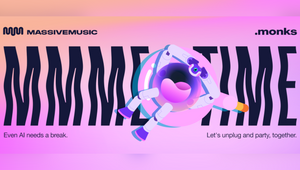
The Sound of Eurovision with Béa Day

With an ear for the adventurous and experimental, Béa Day leads the MassiveMusic creative team in Amsterdam, running sonic branding projects and music productions with the ambition to explore new territories in music and sound.
Originally from Boston, Béa cut their teeth touring the US with a folk band while running a film production company.
In 2015, Béa made the move to the skinny streets of Amsterdam and decided to focus on music full time.
When it comes to music, let's just say Béa would always rather be surprised than satisfied, loving a squelching synth just as much as a heavenly harp or a binaural field recording.
LBB> What past developments or innovations does this year’s Eurovision build upon?
Béa> Eurovision has always lived and breathed music, so for ESC 2025, we wanted to create something deeper, a true sonic identity that encapsulates its Swiss legacy, while creating a modern sound that celebrates Switzerland's diverse musical scenes.
This builds upon Eurovision’s tradition of grand anthems and host-nation musical influences, but now, for the first time, we introduced a consistent, recognisable sonic DNA that can evolve across future contests.
Just like brands use sonic logos to establish instant recognition, Eurovision now has a musical signature that represents its energy, diversity, and spectacle.
LBB> Tell us about some real-world examples that influenced this project.
Béa> Sonic branding is everywhere, think of how Netflix’s “ta-dum” or McDonald's iconic melody immediately trigger brand recognition. Massive events like Eurovision create unique environments where sounds can act as a skeleton for the event, progressing the show while reinforcing their identity through iconic sonic elements.
By fusing Switzerland’s rich musical heritage with modern production methods, we crafted something that celebrates Eurovision’s community, playfulness, and international spirit in a fresh way.
LBB> Have you worked on a project like this before? What did you learn?
Béa> This was a first-of-its-kind project for me, and it was an incredible opportunity to be a part of television history. How to stand out without clashing with the musical acts? How to balance tradition with reinvention?
Eurovision has decades of history, and it’s also known for bold, unexpected moments. We had to honour its roots while ensuring the sound felt progressive, dynamic, and fit for future editions. As with other event-focused projects, a modular sound approach was essential for flexibility and longevity of the sound.
LBB> For non-specialists, what are the technical aspects we should know?
Béa> The sonic identity for ESC 25 is built on a few key elements:
- A bold, anthemic character that embodies the contest’s scale and drama
- A pulsing rhythm to create excitement and anticipation
- Strong links to Swiss identity, including Basel-based yodellers, iconic drum corps, as well as a blend of traditional instruments with natural Swiss soundscapes
- A catchy, six-note melody that can be adapted across different touchpoints like intros, transitions, anticipation moments around scoring, postcards, and more.
- This wasn’t just about a DNA track, it’s a full sonic ecosystem that ensures Eurovision sounds like Eurovision wherever it’s heard.
LBB> What challenges did you face while developing this identity?
Béa> The biggest challenge was capturing Eurovision’s essence without making it feel dated, tied to one specific era, or too closely to one country. All the components are there (melody, structure, rhythm) ready for adaptation to the next host country. The contest is about innovation, spectacle, and community, so the sound had to feel timeless yet fresh.
Another challenge was creating something that works across cultures. Eurovision is a global event, so the sonic branding needed to feel universal while still feeling Swiss, but leaving room for host-country adaptations in future editions.
LBB> Looking ahead, what’s the bigger picture for sonic branding in Eurovision?
Béa> This project is just the start. Sonic branding is becoming more critical in entertainment, and we expect Eurovision’s new identity to evolve with each contest, offering localised variations while keeping its core DNA intact.
There’s also massive potential for immersive and interactive experiences, like AI-powered remixes, digital sound activations, and fan-driven musical adaptations.
Eurovision has always been about pushing creative boundaries, and now, with its first-ever sonic identity, it has a sound as bold, vibrant, and unforgettable as the event itself.















